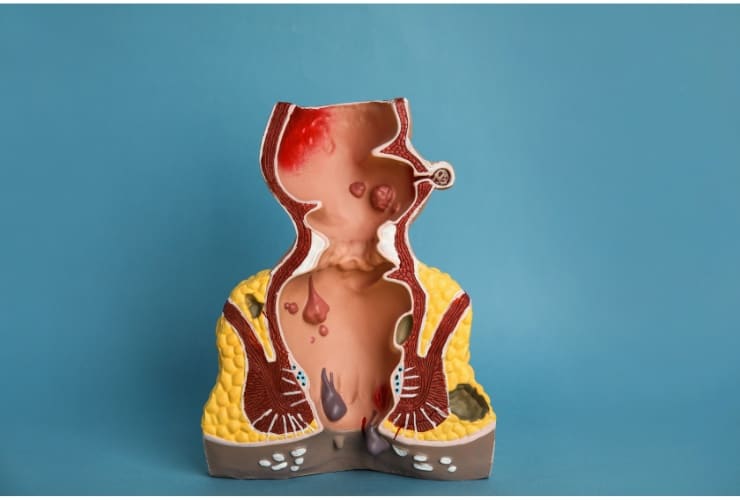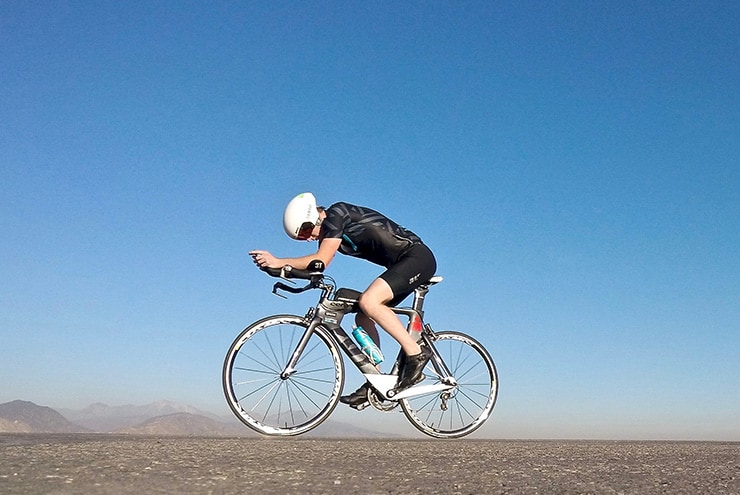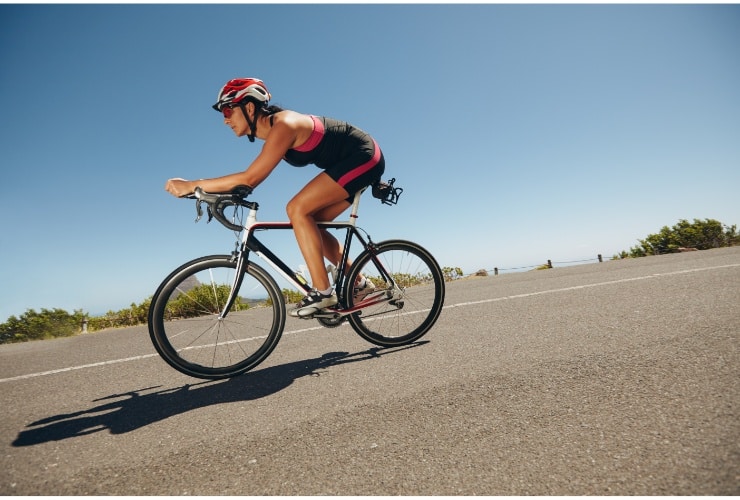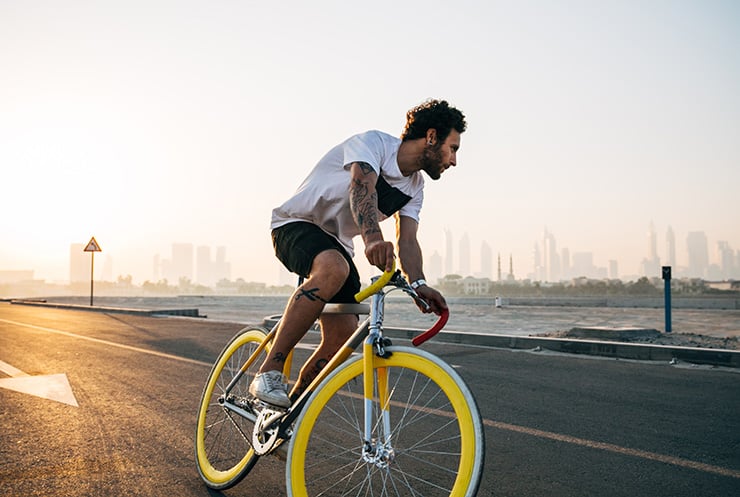The topic of cycling and hemorrhoids have been an ongoing conversation for decades. Are the two related? Can cycling cause hemorrhoids?
The short answer is no. Cycling does not cause hemorrhoids, even though plenty of people still believe that they do. However, cycling with hemorrhoids may irritate them and make the condition worse.
This article will cover everything you need to know about cycling and hemorrhoids. Keep reading to learn the best prevention and recovery tips.
Key Takeaways
- Cycling does not cause hemorrhoids, but it can aggravate them and make them worse due to pressure and restricted blood circulation.
- To make cycling more comfortable with hemorrhoids, you can drink more water, use ointment, choose a suitable seat, wear padded shorts and sit properly.
- To prevent hemorrhoids, you should drink lots of water, eat enough fiber, exercise regularly and avoid sitting on the toilet for long periods.
- If you have hemorrhoids, you can try some home treatment options such as using lotion, taking a warm bath, applying ice packs and taking pain relievers.
What Exactly Are Hemorrhoids?
Hemorrhoids are swollen veins located in your anal region. There are two different kinds of hemorrhoids, including internal and external.
Any hemorrhoid can become a thrombosed hemorrhoid, meaning they fill with blood clots.
External hemorrhoids can lead to irritation, itchiness, pain, swelling, and bleeding. Symptoms of internal hemorrhoids include bowel movements accompanied by painless bleeding and irritation and pain in some cases. This is often why they are associated with cycling – because if you’re unlucky enough to suffer with them, you’ll likely be made aware of it when you’re sitting on a bike!
While hemorrhoids are uncomfortable, they are also common; three out of four adults will experience this condition at some point. Fortunately, there are some easy ways to treat hemorrhoids.

What Causes Hemorrhoids?
Hemorrhoids develop due to increased pressure on the lower rectum. The increased pressure leads to swelling and inflammation of the rectal and anal veins. This is also likely one of the reasons for the misconception about cycling causing hemorrhoids.
But the truth is, many things can cause an increase of pressure on your lower body, including straining during bowel movements, weight gain, sitting for long periods of time, low-fiber diets, and lifting heavy objects. Cycling does not fit into one of these categories.
Certain populations are also more at risk for hemorrhoids, including pregnant women. Obesity and old age are also risk factors.
Check out this video for a bit more information on hemorrhoids:
The Truth About Cycling and Hemorrhoids
It’s easy to assume that cycling can cause hemorrhoids. Since sitting for long periods is a risk factor, wouldn’t riding a bike do the trick?
Even though this is a logical deduction, it is not necessarily true. While cycling may aggravate hemorrhoids, it will not cause the condition.
It takes a lot to cause hemorrhoids just from sitting. First, hard surfaces will cause much more pressure on your veins than soft surfaces.
Furthermore, sitting on the toilet for long periods will cause more pressure than any other chair or surface, making it one of the leading causes of hemorrhoids.
So as you can see, a bike seat is not likely to cause enough pressure to cause hemorrhoids. However, that doesn’t necessarily mean you’re safe to ride when you have hemorrhoids.

Can Cycling Make Hemorrhoids Worse?
Since hemorrhoids are quite common, you will probably experience them at some point in your cycling career. While cycling does not cause hemorrhoids, can it make them worse?
Cycling can irritate hemorrhoids due to too much pressure and restricted blood circulation, causing them to swell and flare up. This can lead to pain, irritation, and everything else you are trying to avoid.
Sitting for a prolonged period on your saddle will just make your hemorrhoids worse, so your best bet is to take a break until you heal.
Is It Okay to Bike With Hemorrhoids?
While biking with hemorrhoids may be uncomfortable and cause flare-ups, it is still okay to bike.
You will need to bike at your own discretion, though, as everyone is different. Certain hemorrhoid conditions may be worse than others.
You may want to consider putting down the bike for a bit if you have external hemorrhoids or thrombosed hemorrhoids. These types of hemorrhoids can be extremely uncomfortable and cause pain.
External hemorrhoids can be painful as they are located on your skin, not inside your body. Cycling can irritate these swollen veins and lead to bleeding external hemorrhoids.
On the other hand, thrombosed hemorrhoids are when a blood clot forms inside. These blood clots can be a great source of pain.
To conclude, it’s okay to bike with hemorrhoids. However, it won’t help with the healing process. In fact, it can slow it down and prolong the pain.
How to Cycle With Hemorrhoids
If cycling is your number one way to exercise and you don’t want to give it up, don’t lose hope. There are a few ways to make cycling with hemorrhoids more comfortable.
However, remember that following all of these tips may not prevent your hemorrhoids from getting worse, depending on your specific case.
Furthermore, if you find that your hemorrhoids become more painful or start to bleed more, make sure to see a doctor. Your condition worsening may be a sign you need additional treatment, such as rubber band ligation.
Bring Water
While drinking water is essential for any workout, this is critical for cycling with hemorrhoids. Staying hydrated helps to manage and reduce symptoms that lead to hemorrhoid flare-ups.
So if you will be in the bike saddle for quite some time, bring more water than usual. I recommend bringing at least two bottles of water or picking a route where you can access water (like a water fountain or convenience store).
Go for a Walk Beforehand

Going for a short, brisk walk is an easy way to reduce further pain in the affected area. Walking before you cycle will increase blood flow in your legs and thus decrease the chances of blood clots, irritation and rectal bleeding.
Use Ointment
Riding a bike with already sensitive tissue will probably result in even more discomfort and pain. However, using ointment can help prevent this.
There are many over-the-counter creams you can find at your local drugstore. Just ask your pharmacist for some recommendations.
Ointments will help prevent further irritation, itchiness and discomfort while riding. Creams and ointments can also reduce bacterial growth and prevent swelling.
Many seasoned cyclists will use ointments such as Doctor Butler’s Hemorrhoid Ointment, Anusol Plus and Preparation H Anti Itch Cream.
If you want a more natural option, you can apply witch hazel to your external hemorrhoid tissue. This product will do many of the same things that other ointments do, such as decrease swelling and irritation.
Make Sure Your Seat Is Comfortable
Obviously, sitting on a hard lump of a seat isn’t going to help anybody. Making sure your seat is comfortable is essential for biking with hemorrhoids.
A softer seat will help to decrease pressure on your anal region. Furthermore, make sure you are using a properly sized saddle; this will make all the difference.
Something to keep in mind is that every cyclist is different. While a soft seat may work great for one rider, some prefer a firm leather saddle. Do your best to try out different shapes, sizes and materials, and choose the best one for you.
Bike Seat Recommendations for Cycling with Hemorrhoids
This section will review some of the best bike seats for riding with hemorrhoids. Whether you’re on a budget or are willing to splurge a little, this list will have something for everybody.
Hobson Easyseat II
This is one of the best bike seats for those riding with hemorrhoids. The two cushions help to relieve pressure and reduce chafing and numbness.
Due to the cutaway design, you will experience better blood flow and ventilation, making for a more comfortable ride.
YLG Oversized Comfort Bike Seat
The YLG Oversized bicycle seat is for men and women and offers a wider, more breathable design. The thick foam padding helps to reduce pain, while the shock absorption springs help to relieve pressure. This seat will be a good pick if you want the best bike seat for internal hemorrhoids.
Sit on Your Seat Properly
One of the easiest ways to prevent further pain while cycling is to ensure you are properly sitting on your saddle.
Ideally, your sit bones (or sitz bones) should be in full contact with the bike seat. If they aren’t, you may need to adjust the seat, adjust your position or get a new seat that fits you better.
Your sit bones are located at the bottom of your pelvis and help to absorb pressure and weight while you sit.
Sitting properly will reduce pressure on your rectal veins, ultimately decreasing hemorrhoid discomfort.
Wear Padded Cycling Shorts
Depending on what you wear, your clothes can irritate hemorrhoids. Padded bike shorts can help you feel more comfortable while riding with hemorrhoids.
The extra cushioning of padded shorts will help to reduce friction. If you don’t have a pair, it may be a good idea to invest in some, especially if you will be going on longer rides.

How to Prevent Hemorrhoids
Perhaps you are not currently struggling with this condition but want to do everything you can to avoid hemorrhoids.
Keep reading to learn three effective yet easy ways to prevent developing hemorrhoids.
Drink Lots of Water
Drinking plenty of water will prevent constipation by keeping your stools soft. Ideally, you should be drinking around eight cups of water each day.
If you find it hard to drink that much water each day, try drinking tea or consider adding flavour to your water.
Make Sure You’re Getting Enough Fiber
Most medical expertise sources highlight that one of the main ways to prevent hemorrhoids is ensuring you’re eating a healthy diet and getting enough fiber.
Much like water, fiber increases the softness of your stool. This will decrease the time you’re on the toilet and prevent you from straining when going to the bathroom.
There are a few ways to transform your low-fiber diet, including eating fiber-rich foods and taking fiber supplements.
Foods that are rich in fiber include whole grains like oatmeal and brown rice, vegetables like broccoli and green beans, dried fruit, berries, avocados, potatoes and nuts.
If you want a few more tips and tricks to increase fiber, check out this video:
Exercise Regularly
An easy way to decrease the chances of developing hemorrhoids is to exercise regularly. First of all, maintaining a healthy body weight is important, as those who are overweight are more at risk of developing hemorrhoids.
Furthermore, an active lifestyle will decrease pressure on your blood vessels, stopping the development of hemorrhoids. Exercising also reduces constipation.
Pressure typically builds the longer you sit; being active greatly reduces the risk of developing this condition.
Avoid Sitting on the Toilet for Long Periods
If you find yourself sitting on the toilet for longer periods of time, this will be a habit to change. The shape of the toilet puts a high amount of pressure on the anus and rectum, encouraging the development of hemorrhoids.
Passing stool should not take more than five minutes at a time. Try to go only when you need to and eat fibrous foods, as mentioned above, to help speed up the process.
Treatment Options
Even if you do all of the above to try to prevent hemorrhoids, it’s not a guarantee that you won’t. If you are unlucky and do develop hemorrhoids, try not to worry. While most hemorrhoids will go away on their own in about a week, there are a few things you can do to calm inflamed hemorrhoids and increase comfort.
Fortunately, many of these are home treatment options. You don’t necessarily have to visit a drugstore to experience relief from this condition.
- Drink water. The easiest way to soothe hemorrhoid irritation is to drink more water. Try to drink at least six glasses of water per day.
- Use lotion or soothing wipes. After bowel movements, try to use baby wipes to clean yourself. If you don’t have wipes or a warm wet cloth, you can also put lotion on your toilet paper to increase comfort.
- Apply ointments. Another treatment option is ointments. There are several ointments you can buy at your local drugstore that will help soothe those pesky hemorrhoids. If you need cream for internal use, petroleum jelly will work well. Hydrocortisone creams work well for external use to relieve irritation and itchiness.
- Take a warm bath. Another easy way to reduce pain is to take a bath. Sitting in warm water can help decrease swelling and relax your muscles. (Make sure to avoid using hot water.)
- Increase fiber intake. Increasing fiber intake is important when dealing with hemorrhoids. Whether you change to a high-fiber diet or start taking supplements or stool softeners, you will experience relief relatively quickly.
- Take pain relievers. If you’re experiencing discomfort, taking oral pain relievers is another option. Ibuprofen, acetaminophen or aspirin will work for this.
- Use an ice pack. Applying an ice pack to the affected area for a few minutes will help to numb the area and decrease swelling and discomfort.
Final Thoughts
In conclusion, cycling does not cause hemorrhoids, but the activity can make this condition worse.
However, you can do a few things to make your ride more comfortable, including drinking plenty of water, going for a walk before you exercise, using ointment and investing in a comfortable seat.
When it comes to prevention, things like drinking lots of water, increasing your fiber intake and exercising regularly will help you maintain a healthy digestive system.
Leave a comment if you enjoyed this article, and let us know your best tips to make cycling more comfortable with hemorrhoids.

